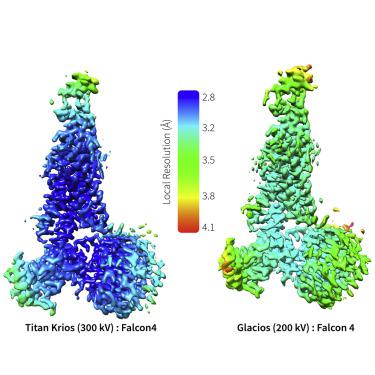Structure ( IF 4.4 ) Pub Date : 2021-05-05 , DOI: 10.1016/j.str.2021.04.008 Xin Zhang 1 , Rachel M Johnson 1 , Ieva Drulyte 2 , Lingbo Yu 2 , Abhay Kotecha 2 , Radostin Danev 3 , Denise Wootten 4 , Patrick M Sexton 4 , Matthew J Belousoff 4

|
G protein-coupled receptors (GPCRs) are the largest class of cell surface drug targets. Advances in stabilization of GPCR:transducer complexes, together with improvements in cryoelectron microscopy (cryo-EM) have recently been applied to structure-assisted drug design for GPCR agonists. Nonetheless, limitations in the commercial application of these approaches, including the use of nanobody 35 (Nb35) to aid complex stabilization and the high cost of 300 kV imaging, have restricted broad application of cryo-EM in drug discovery. Here, using the PF 06882961-bound GLP-1R as exemplar, we validated the formation of stable complexes with a modified Gs protein in the absence of Nb35. In parallel, we compare 200 versus 300 kV image acquisition using a Falcon 4 or K3 direct electron detector. Moreover, the 200 kV Glacios-Falcon 4 yielded a 3.2 Å map with clear density for bound drug and multiple structurally ordered waters. Our work paves the way for broader commercial application of cryo-EM for GPCR drug discovery.
中文翻译:

用于 GPCR 药物发现的不断发展的冷冻电镜结构方法
G 蛋白偶联受体 (GPCR) 是最大的一类细胞表面药物靶标。GPCR:传感器复合物稳定化方面的进展,以及冷冻电子显微镜 (cryo-EM) 的改进,最近已应用于 GPCR 激动剂的结构辅助药物设计。尽管如此,这些方法在商业应用中的局限性,包括使用纳米体 35 (Nb35) 来帮助复杂稳定化和 300 kV 成像的高成本,限制了冷冻电镜在药物发现中的广泛应用。在这里,以 PF 06882961 结合的 GLP-1R 为例,我们验证了在没有 Nb35 的情况下与修饰的 Gs 蛋白形成稳定复合物。同时,我们使用 Falcon 4 或 K3 直接电子探测器比较了 200 和 300 kV 的图像采集。此外,200 kV Glacios-Falcon 4 产生了 3。2 Å 地图,结合药物和多个结构有序的水的密度清晰。我们的工作为cryo-EM在GPCR药物发现中的更广泛商业应用铺平了道路。











































 京公网安备 11010802027423号
京公网安备 11010802027423号